Match the following.
(Coloumn I) -----
(Coloumn II)
a. Mixotrophic protist - (i) Peranema
b. Plasmodial slime mould - (ii) Polysphondylium
c. Holozoic protist - (iii) Euglena
d. Saprobic protist - (iv) Physarum
e. Communal slime mould - (v) Rhabdomonas
a(ii), b(iv), c(i), e(v), d(iii)
a(i), b(ii), c(iii), d(iv), e(v)
a(iii), b(iv), c(i), d(ii), e(v)
a(i), b(iii), c(ii), d(iv), e(v)
The correct Answer is:C
To solve the matching question, we will analyze each item in Column I and find the appropriate match in Column II based on the definitions and characteristics of the organisms mentioned.
1. Identify Mixotrophic Protist:
- A mixotrophic protist is one that can perform both autotrophic (photosynthesis) and heterotrophic (ingesting food) nutrition.
- Among the options in Column II, Euglena is known for its ability to photosynthesize as well as consume organic matter.
- Match: a. Mixotrophic protist - (iii) Euglena
2. Identify Plasmodial Slime Mould:
- Plasmodial slime moulds are characterized by a large, multinucleate cell (plasmodium) that can move and engulf food.
- Physarum is a well-known example of a plasmodial slime mould.
- Match: b. Plasmodial slime mould - (iv) Physarum
3. Identify Holozoic Protist:
- Holozoic protists are those that ingest solid food, typically by engulfing it.
- Peranema is a protist that exhibits holozoic nutrition by engulfing food particles.
- Match: c. Holozoic protist - (i) Peranema
4. Identify Saprobic Protist:
- Saprobic protists feed on dead and decaying organic matter.
- Polysphondylium is a saprobic protist that belongs to the group of cellular slime moulds.
- Match: d. Saprobic protist - (ii) Polysphondylium
5. Identify Communal Slime Mould:
- Communal slime moulds are those that live in a community association.
- Rhabdomonas is known to exist in communal associations.
- Match: e. Communal slime mould - (v) Rhabdomonas
Final Matches:
- a. Mixotrophic protist - (iii) Euglena
- b. Plasmodial slime mould - (iv) Physarum
- c. Holozoic protist - (i) Peranema
- d. Saprobic protist - (ii) Polysphondylium
- e. Communal slime mould - (v) Rhabdomonas
Summary of Matches:
- A - iii
- B - iv
- C - i
- D - ii
- E - v
- A mixotrophic protist is one that can perform both autotrophic (photosynthesis) and heterotrophic (ingesting food) nutrition.
- Among the options in Column II, Euglena is known for its ability to photosynthesize as well as consume organic matter.
- Match: a. Mixotrophic protist - (iii) Euglena
- Plasmodial slime moulds are characterized by a large, multinucleate cell (plasmodium) that can move and engulf food.
- Physarum is a well-known example of a plasmodial slime mould.
- Match: b. Plasmodial slime mould - (iv) Physarum
- Holozoic protists are those that ingest solid food, typically by engulfing it.
- Peranema is a protist that exhibits holozoic nutrition by engulfing food particles.
- Match: c. Holozoic protist - (i) Peranema
- Saprobic protists feed on dead and decaying organic matter.
- Polysphondylium is a saprobic protist that belongs to the group of cellular slime moulds.
- Match: d. Saprobic protist - (ii) Polysphondylium
- Communal slime moulds are those that live in a community association.
- Rhabdomonas is known to exist in communal associations.
- Match: e. Communal slime mould - (v) Rhabdomonas
- a. Mixotrophic protist - (iii) Euglena
- b. Plasmodial slime mould - (iv) Physarum
- c. Holozoic protist - (i) Peranema
- d. Saprobic protist - (ii) Polysphondylium
- e. Communal slime mould - (v) Rhabdomonas
- A - iii
- B - iv
- C - i
- D - ii
- E - v
Topper's Solved these Questions
Similar Questions
Knowledge Check
Unlike plasmodial slime moulds, cellular slime molds :
Aa) can move as an amoeboid massBb) are haploid organisms except for the giant-celled zygoteCc) have more than one nucleus per cellDd) form fruiting bodies
Match the coloumn-I with column-II

View SolutionNutrition in protists is
View SolutionMost phases of the life cycles of plasmodial slime moulds are
View SolutionWhich of the following is a slime mould
View SolutionWhich of the following is a slime mould
View SolutionWhich of the following is a slime mould
View SolutionMixotrophic nutrition is present in
(a) Amoeba
(b) Navicula
(c) Plasmodium
(d) Euglena
View Solution


